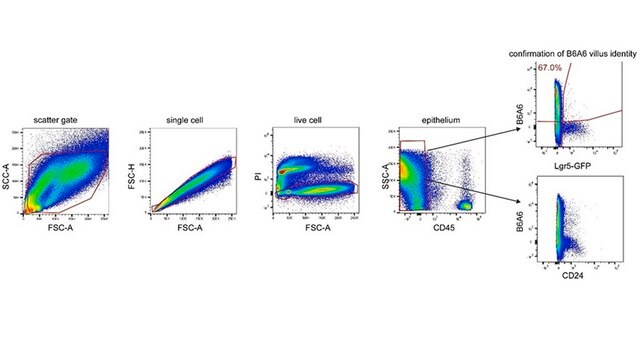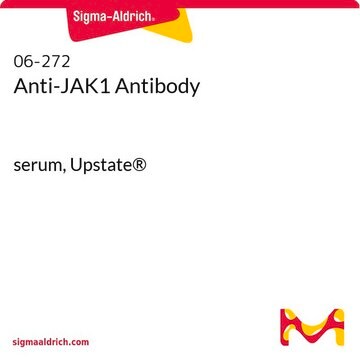MABS1299
Anti-PAR4 Antibody, clone 14H6
clone 14H6, from mouse
Sinônimo(s):
Proteinase-activated receptor 4, PAR-4, Coagulation factor II receptor-like 3, Thrombin receptor-like 3
About This Item
Produtos recomendados
fonte biológica
mouse
Nível de qualidade
forma do anticorpo
purified immunoglobulin
tipo de produto de anticorpo
primary antibodies
clone
14H6, monoclonal
reatividade de espécies
human
técnica(s)
flow cytometry: suitable
immunocytochemistry: suitable
western blot: suitable
Isotipo
IgG2bκ
nº de adesão NCBI
nº de adesão UniProt
modificação pós-traducional do alvo
unmodified
Informações sobre genes
human ... F2RL3(9002)
Descrição geral
Especificidade
Imunogênio
Aplicação
Immunocytochemistry Analysis: A representative lot detected endogenous PAR4 by fluorescent immunocytochemistry staining of 4% formaldehyde-fixed human platelets. Thrombin treatment diminished PAR4 immunoreactivity (Mumaw, M.M., et al. (2015). Thromb. Res. 135(6):1165-1171)
Flow Cytometry Analysis: A representative lot detected tetracycline-induced expression of exogenously transfected human PAR4 on the surface of HEK293 Flp-In cells. Thrombin treatment diminished cell surface PAR4 immunoreactivity (Mumaw, M.M., et al. (2015). Thromb. Res. 135(6):1165-1171).
Western Blotting Analysis: A representative lot detected MBP fusion proteins containing human PAR4 fragment a.a. 18-78, 41-66, or 48-72. MBP-PAR4 fusion cleavage by thrombin ablolished target band detection by clone 14H6 (Mumaw, M.M., et al. (2015). Thromb. Res. 135(6):1165-1171).
Western Blotting Analysis: A representative lot detected tetracycline-induced expression of exogenously introduced human PAR4 in a HEK293 Flp-In cell line, as well as endogenous PAR4 in isolated human platelets (hPLTs). Thrombin activation of hPLTs diminished PAR4 target band detection (Mumaw, M.M., et al. (2015). Thromb. Res. 135(6):1165-1171).
Qualidade
Western Blotting Analysis: A 1:250 dilution of this antibody detected PAR4 in 50 µg of human platelet lysate.
Descrição-alvo
forma física
Outras notas
Não está encontrando o produto certo?
Experimente o nosso Ferramenta de seleção de produtos.
Código de classe de armazenamento
12 - Non Combustible Liquids
Classe de risco de água (WGK)
WGK 1
Ponto de fulgor (°F)
Not applicable
Ponto de fulgor (°C)
Not applicable
Certificados de análise (COA)
Busque Certificados de análise (COA) digitando o Número do Lote do produto. Os números de lote e remessa podem ser encontrados no rótulo de um produto após a palavra “Lot” ou “Batch”.
Já possui este produto?
Encontre a documentação dos produtos que você adquiriu recentemente na biblioteca de documentos.
Nossa equipe de cientistas tem experiência em todas as áreas de pesquisa, incluindo Life Sciences, ciência de materiais, síntese química, cromatografia, química analítica e muitas outras.
Entre em contato com a assistência técnica





